Spring means Barbecue!
Sunday, March 25th, 2007 10:00 am by NealLast September, we revealed this secret barbecue recipe for the best damned southern pork barbecue you will ever eat. In the intervening winter months, we’ve grilled plenty of dogs, burgers, steaks and chicken, but the only new grill recipe we’ve developed is an amazing brine-smoked turkey. But that’s another column.
Spring is in full bloom in Georgia right this second, and along with the budding flowers and trees, grills and lawnmowers are coming to life after a sleepy winter. Spring festivals, accompanied by fragrant chicken barbecuing on the courthouse square, are right around the corner.
In that spirit, and for those who missed it the first time, we again present “Pork Barbecue, Georgia Style” in its entirety.
Enjoy. And get outside.
***
Here’s the latest installment from “The Southchild Cookbook”: Georgia-style, Southern Pork Barbecue. There are many, famous styles of barbecue across this great nation, each with it’s own meat, style of cooking, rubs and sauces. Texas is known for its beef briskets, Kansas for its sweet sauces, South Carolina for its mustard-based sauces, and so on. The barbecue we present here is all Georgia: hardwood-smoked pork with a flavorful rub and a vinegar-based sauce. This is the barbecue that I grew up eating in central Georgia and that, with some hunting, still can be found at small-town barbecue joints across central and north Georgia.
The essence of this barbecue is the slow-cooked, hardwood-smoked (we use pecan wood) pork shoulder, commonly called a “Boston Butt” in the supermarket. The sauce is the other key, defining characteristic. Expect to pay between $1.20 – $1.50 a pound for the pork shoulder, and expect to spend between 30 minutes – 1 hour cooking time per pound of meat. I cook the pork on a standard-sized, outdoor grill over charcoal and hardwood; although, a gas grill or more traditional smoker will work as well. The shoulder bone is quite minimal, so a 9 pound “Butt” will produce quite a bit of meat. Given that per pound, the shoulder is one-third the cost of meat-stingy “baby back ribs” this is quite a good deal, economically, if you’re willing to invest the time needed to cook it properly. The sauce should be made ahead of time as it keeps well without refrigeration. The rub should be made with fresh spices for maximum flavor and keeps well in a sealed jar (I use a mason jar) in the refrigerator.
This recipe includes enough rub for an average-sized Boston Butt between 7 – 9 pounds. The sauce recipe makes a gallon but can be halved if less is desired. I make the whole batch of sauce and use it not only for this recipe but also on anything I want to barbecue such as chicken (either baked in the oven or pan-fried leftovers).
OK, enough history.
I. Here, in order, is how you do it:
- Make the sauce. The recipe follows.
- Make the rub while the sauce is cooking. Again, the recipe is below.
- Prep the pork. Remove from the package, wash with cold water to remove any preservatives, and dry thoroughly with paper towels. Place on a metal or plastic baking tray to receive the rub.
- Rub-down the meat on all sides with the rub mixture. I prefer not to trim any fat from the shoulder as the fat “melts” into the meat while cooking thus keeping it moist. Rub the spice mixture into the meat with your hands. Coat it completely and use hands to ensure that all nooks and crannies in the shoulder receive the rub. Let it sit until the grill is ready.
- Get the grill ready. There are two, important things to keep in mind: (1) Use indirect heat: this means that the meat should not cook directly over the coals/gas and wood. The photos below demonstrate how I accomplish this with my grill. Use a similar approach with yours. (2) Cook the meat at a temperature betwen 225 – 260 degrees Farenheit. If your grill doesn’t have a built-in thermometer then use an oven thermometer to make sure you don’t get it too hot. At 225 degrees, expect 50 minutes – 1 hour cooking time per pound of meat. At 250 degrees, expect 35-45 minutes per pound. If the grill gets too hot during cooking, open up the lid to cool it down. Shut off the airflow by closing the grill vents if necessary: you want to keep it at or under 250.
Note: When grilling with charcoal, add fresh coals/wood every hour or so as needed.
- Place the meat on the grill with the fattier side up, so that the fat can “melt” down through the shoulder as it slowly cooks. Cook the meat with the lid closed for maximum smokeage, and at approximately half the recommended cooking time, spray the meat with a mixture of water, red cider vinegar, salt and pepper. Then, turn the meat over and continue cooking. After spraying, you may wrap the meat in aluminum foil for the remainder of cooking for increased moisture (most BBQ cooks agree that, after four hours the meat will not absorb any additional smoke flavor).
- Use the recommended times but check for “doneness” by using tongs and pulling on the shoulder bone. The bone will become visible when the cooked meat starts to “pull away” from it signifying that it is almost done. If the bone is “loose”, then the barbecue is definitely ready. The final temperature will be over 170 degrees farenheit; although, it isn’t necessary to check with a thermometer. If you’ve followed the recommendations, it will be plenty done. The reason we slowly cook the pork to this extent is NOT to ensure it’s done (you can safely eat it at 160 degrees), but to ensure that it’s tender. As with a beef brisket, the higher temperatures convert any tough tissues and collagen into gelatin which flavors and tenderizes the meat.
- Pull the meat off the bone and chop the meat into small pieces. Some folks don’t include the remaining fat in the mix, but I suggest you at least include some for flavor and texture. The charred, yummy “crust†may need to be chopped separately as it is hard and crunchy, but don’t leave it out! Mix together, and you have un-sauced barbecue! At this point, you can serve “as is†or mix with sauce. You don’t want to over-sauce the meat, so start with a little, give it a taste, and add more until the flavor is just right.
Here are the details and photos to show you what to expect:
II. Let’s start with the recipe for the sauce:
* 1 gallon red, cider vinegar
* 12 ounces ketchup
* 1/3 cup salt
* 1/4 cup black pepper
* 1 pint water
* 4 ounces yellow mustard
* 1 cup sugar
* 1/4 cup crushed, red pepper flakes
* 1 (mild) – 4 (hot) tablespoons cayenne pepper
Mix the ingredients in a large pot. Bring to a boil. Simmer on medium heat for one hour. When sufficiently cool, transfer the sauce to a storage vessel. I use a large, Maker’s Mark whiskey bottle (hey, if you’re going to drink whiskey, drink good whiskey). This sauce keeps indefinitely when stored in a dark, unrefrigerated space like a cabinet or pantry.
III. Here’s the recipe for the rub:
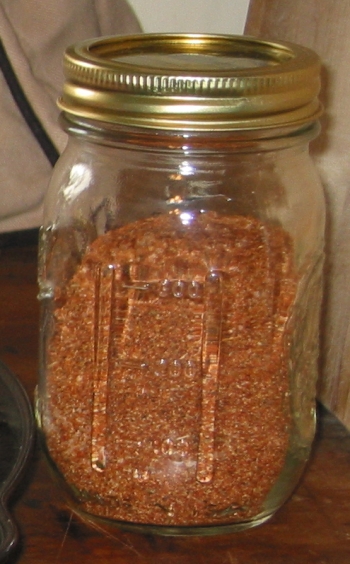 |
| A jar of rub. |
* 3 tablespoons kosher salt (or any coarse salt)
* 1/4 cup dark brown sugar
* 1/4 cup sweet paprika
* 3 tablespoons black pepper
* 1 tablespoon granulated garlic
* 1 tablespoon granulated onion (or onion powder)
* 1 tablespoon ground cumin
* 1/2 to 1 teaspoon cayenne pepper
Mix together in an airtight jar. Store in the refrigerator until needed. This is enough rub for a typical 7-9 pound Boston Butt, so if you’re cooking more than this then make sure to have enough rub on hand.
IV. Photos and Tips:
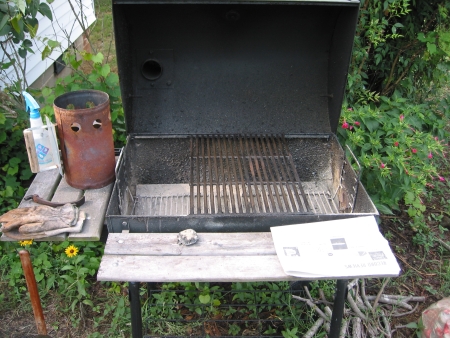 |
| Prepping the grill: The coals will be on the sides, the meat in the middle for a classic, indirect grilling. |
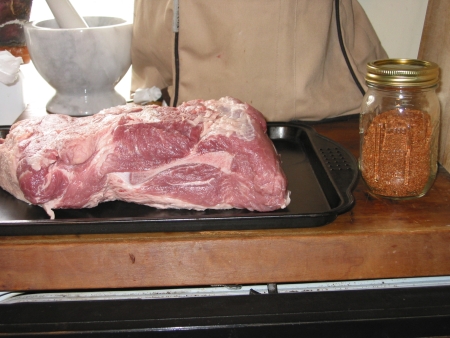 |
| Prepping the meat: Here’s the raw shoulder (aka “Boston Butt”) with the jar of spice rub ready to be applied. |
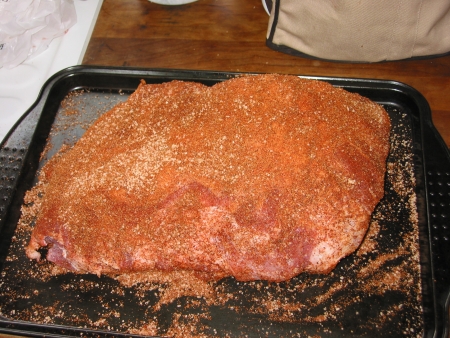 |
| Prepping the meat: Here’s the meat with the rub generously applied over the entire surface. |
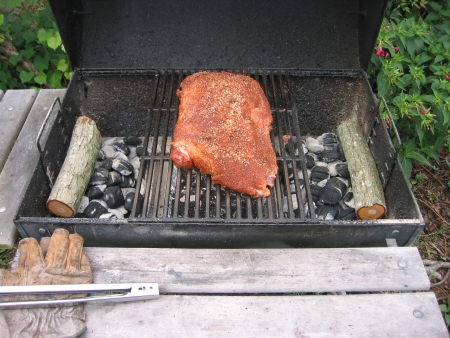 |
| Start cooking! Notice the coals and pecan logs on the sides with the meat in the middle: this is the classic, indirect grilling setup. Also, note that I put a piece of foil directly under the pork to “catch” any fat drippings. You’ll be glad you did when it comes time to clean up. Smoke the pork with the grill lid closed. |
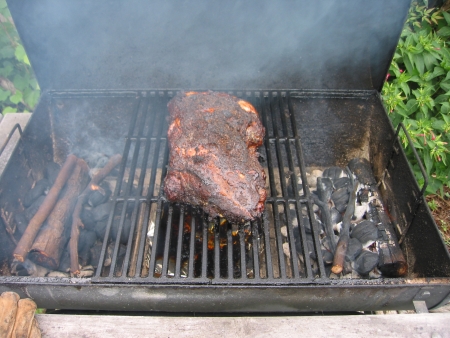 |
| Here’s what your pork should look like after a few hours. |
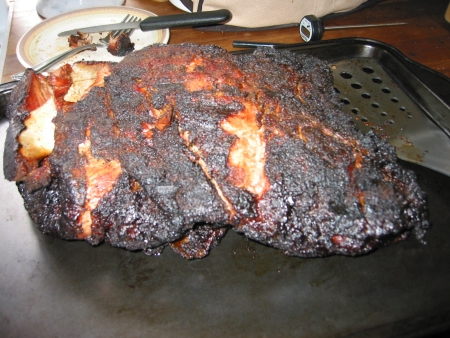 |
| The meat is done! Notice the white bone on the far left — it is literally sticking-out as the meat has pulled away from it. This is a sure sign of “doneness”. |
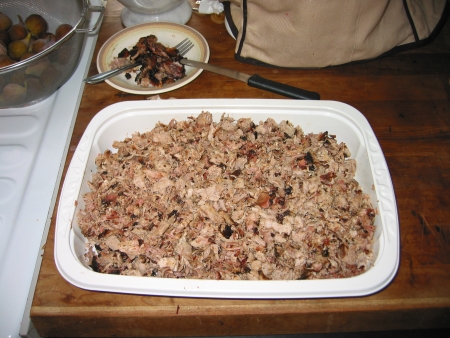 |
| Pull the bone out and chop the meat into small pieces. The charred, yummy “crust” may need to be chopped separately as it is hard and crunchy, but don’t leave it out! Mix together, and you have un-sauced barbecue! At this point, you can serve “as is” or mix with sauce. Either way, your taste buds will reward you greatly. |
If you are a fan of authentic, Southern barbecue then give this recipe a try. The pork, rub and sauce can be had for less than $20, and in one day you can cook the best barbecue you’ve ever eaten. Let me know what you think: send e-mail to southchild@gmail.com.
Cheers.